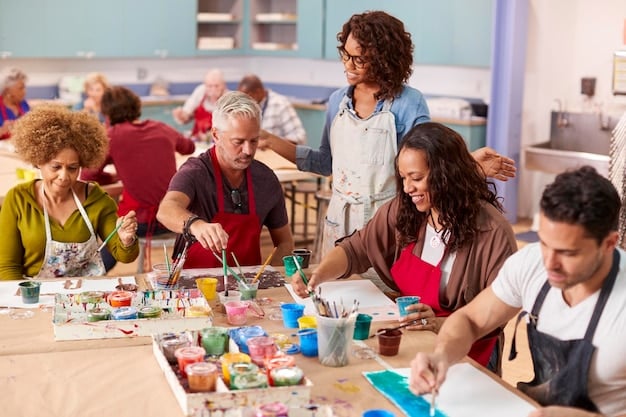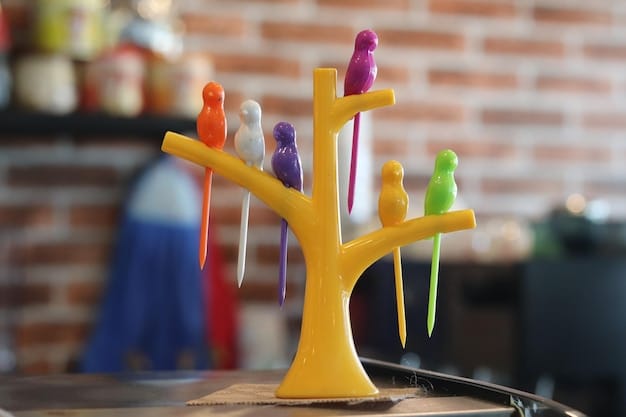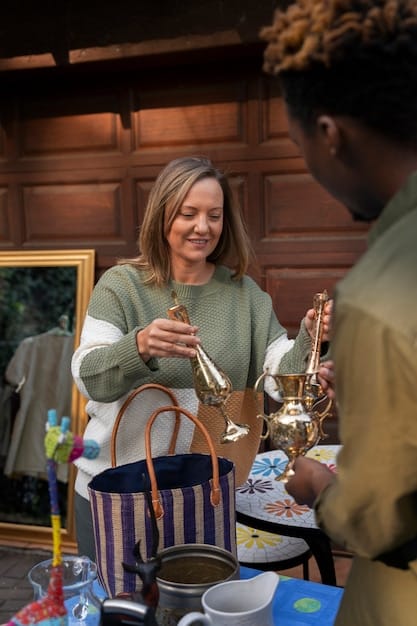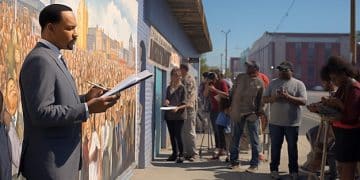Sustainable Funding Models for Community Arts Centers: A Best Practices Guide

Community Arts Centers: Best Practices for Sustainable Funding Models explores diverse strategies, from diversified revenue streams like individual donors and corporate sponsorships to innovative approaches like crowdfunding and social enterprises, ensuring long-term financial stability and community impact.
Community arts centers are vital hubs that enrich communities, foster creativity, and provide access to the arts for all. However, these centers often face challenges in securing sustainable funding to support their programs and operations. This article delves into community arts centers: best practices for sustainable funding models, offering strategies to ensure their long-term viability.
Understanding the Landscape of Arts Funding
Funding for the arts has always been a complex issue, relying on a mixture of public grants, private donations, and earned income. However, recent economic shifts and changes in philanthropic priorities have made it more critical than ever for community arts centers to adopt diversified and sustainable funding models.
The Role of Public Funding
Government funding, through agencies like the National Endowment for the Arts (NEA) and state arts councils, plays a significant role in supporting community arts centers. These grants often provide crucial seed money for projects and operational support.
- Federal Grants: NEA grants are highly competitive but offer substantial funding for innovative projects and community outreach initiatives.
- State Arts Councils: State-level funding often targets specific needs within the state, such as arts education or cultural preservation.
- Local Government Support: Many cities and counties allocate funds to support local arts organizations, recognizing their contribution to the community’s quality of life.
However, relying solely on public funding can be risky, as these sources are subject to political and economic fluctuations. A diversified funding strategy is essential for long-term stability.

A diversified approach involves cultivating multiple revenue streams, reducing dependence on any single source. This strategy not only enhances financial stability but also strengthens the center’s connection with the community.
Building a Robust Individual Donor Base
Individual donors are the backbone of many successful community arts centers. Cultivating a strong base of individual supporters requires consistent engagement, personalized communication, and a clear articulation of the center’s impact.
Strategies for Engaging Individual Donors
Building relationships with individual donors is an ongoing process that requires consistent effort and a genuine connection with their values and interests.
- Membership Programs: Offer tiered membership levels with benefits that appeal to different donor segments, such as discounted tickets, exclusive events, or recognition in publications.
- Annual Giving Campaigns: Launch annual campaigns with specific fundraising goals, highlighting the center’s achievements and future plans.
- Major Donor Cultivation: Identify and cultivate major donors through personalized outreach, private events, and opportunities to engage directly with the center’s programs.
Effective communication is key to retaining donors and encouraging increased support. Regularly communicate the center’s impact through newsletters, social media, and annual reports.

By focusing on building strong relationships with individual donors and communicating the tangible impact of their contributions, community arts centers can cultivate a loyal base of supporters who are invested in their long-term success.
Securing Corporate Sponsorships and Partnerships
Corporate sponsorships can provide significant financial support and valuable in-kind resources to community arts centers. Building mutually beneficial partnerships with local businesses requires understanding their marketing objectives and aligning them with the center’s programs and brand.
Approaching Corporate Sponsors
When seeking corporate sponsorships, it’s essential to present a clear value proposition that benefits both the arts center and the sponsor.
- Identify Potential Partners: Research local businesses that align with the center’s mission and target audience.
- Develop Sponsorship Packages: Create customizable sponsorship packages with varying levels of recognition and benefits, such as logo placement, event tickets, and employee engagement opportunities.
- Highlight Community Impact: Emphasize the positive impact of the center’s programs on the community, showcasing how the sponsorship will support these initiatives.
Strong relationships with corporate sponsors can provide ongoing support and open doors to new opportunities, strengthening the center’s financial stability and community connections.
Cultivating successful corporate partnerships requires a strategic approach, aligning the center’s goals with the business objectives of potential sponsors. This partnership fosters a sense of shared responsibility and demonstrates the value of the arts to the broader community.
Exploring Earned Income Opportunities
Earned income, through activities like ticket sales, classes, workshops, and merchandise, can provide a sustainable revenue stream for community arts centers. Diversifying earned income opportunities can reduce reliance on grants and donations.
Maximizing Earned Revenue
Exploring diverse avenues for earned income can significantly improve a community arts center’s financial sustainability.
- Ticket Sales and Performances: Offer a diverse range of performances and events that appeal to different audiences, and implement dynamic pricing strategies to maximize revenue.
- Arts Education Programs: Provide classes, workshops, and camps for children and adults, offering opportunities for skill development and creative expression.
- Merchandise and Art Sales: Sell merchandise featuring local artists and center branding, and host art exhibitions and sales to generate income and support local talent.
By diversifying earned income opportunities and continuously innovating to meet community needs, community arts centers can build a resilient financial foundation.
An effective strategy involves balancing artistic mission with entrepreneurial ventures, creating a symbiotic relationship that supports both financial sustainability and artistic expression.
Leveraging Technology and Digital Fundraising
Technology offers new avenues for community arts centers to engage with donors, promote their programs, and raise funds. Digital fundraising strategies, such as online giving platforms, crowdfunding campaigns, and social media appeals, can reach a broader audience and streamline the fundraising process.
Utilizing Digital Tools for Fundraising
Leveraging technology can significantly enhance a community arts center’s fundraising efforts and expand its reach.
- Online Giving Platforms: Implement user-friendly online giving platforms that make it easy for donors to contribute, and offer recurring donation options for sustained support.
- Crowdfunding Campaigns: Launch crowdfunding campaigns for specific projects or initiatives, engaging the community and leveraging social media to raise funds.
- Social Media Engagement: Utilize social media platforms to share stories, promote events, and appeal for donations, creating a sense of community and encouraging support.
Embracing technology and digital fundraising strategies can help community arts centers build a broader base of support and secure sustainable funding for their programs.
A strategic approach involves integrating digital tools with traditional fundraising methods, creating a comprehensive strategy that maximizes impact and engagement.
Building Endowments and Planned Giving Programs
Endowment funds and planned giving programs provide long-term financial security for community arts centers, ensuring their sustainability for future generations. Establishing an endowment and promoting planned giving opportunities can attract legacy gifts and create a lasting impact.
Securing Long-Term Financial Stability
Building endowments and planned giving programs is essential for ensuring the long-term financial health of community arts centers.
- Endowment Funds: Establish an endowment fund to provide a stable source of income, and actively solicit major gifts and bequests to grow the fund over time.
- Planned Giving Programs: Promote planned giving opportunities, such as bequests, charitable gift annuities, and charitable remainder trusts, to attract legacy gifts and secure future funding.
- Legacy Societies: Create legacy societies to recognize and honor donors who have made planned gifts, fostering a culture of long-term commitment and support.
By building endowments and promoting planned giving programs, community arts centers can secure their financial future and ensure their ability to serve the community for generations to come.
This proactive approach reflects a commitment to stewardship and sustainability, fostering a culture of philanthropy that supports the center’s mission for years to come.
| Key Point | Brief Description |
|---|---|
| 💰 Diversified Funding | Combining grants, donations, and earned income. |
| 🤝 Corporate Partnerships | Building mutually beneficial relationships with businesses. |
| 📱 Digital Fundraising | Utilizing online platforms & social media for donations. |
| 🌱 Endowment Building | Securing long-term financial stability through legacy gifts. |
Frequently Asked Questions
▼
Sustainable funding comes from diversified sources like individual donations, corporate sponsorships, government grants, earned revenue (ticket sales, classes), endowments, and digital fundraising efforts.
▼
They can attract donors through membership programs, annual giving campaigns, major donor cultivation, personalized communication, and clearly articulating the center’s impact on the community.
▼
Effective strategies include identifying potential partners, developing customizable sponsorship packages, highlighting community impact, and building mutually beneficial relationships with local businesses.
▼
Technology can be used through online giving platforms, crowdfunding campaigns, social media engagement, and leveraging digital tools to expand reach and streamline the fundraising process.
▼
Endowments and planned giving programs provide long-term financial security, attract legacy gifts, ensure sustainability for future generations, and foster a culture of philanthropy.
Conclusion
Sustaining community arts centers requires a multifaceted approach that combines traditional fundraising methods with innovative strategies. By diversifying funding sources, building strong relationships with donors and sponsors, leveraging technology, and focusing on long-term financial planning, these vital hubs can ensure their continued impact on communities for generations to come.





